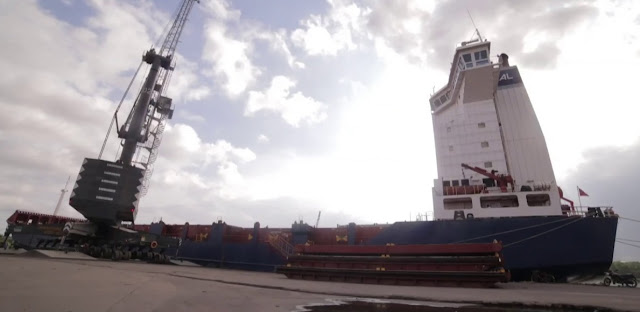Even as Prime Minister Narendra Modi proposes to inaugurate on Thursday India’s second riverine Multi-Modal terminal (MMT) at Sahibganj in Jharkhand, built at a cost of Rs 290 crore reportedly in a record time of about two years, several civil rights organizations* have said that the government has failed to address the high-profile terminal’s social and environmental concerns.

While the Government of India claims that the terminal would open up industries of Jharkhand and Bihar to the global market and provide Indo-Nepal cargo connectivity through waterways route, and some of the commodities with will be transported would include coal, stone chips, fertilizers, cement and sugar, a statement by the civil rights organizations says that the people of Sahibganj have “lost their land and are on the edge of losing their livelihood.”
The second Jal Marg Vikas Project – the first one being the MMT at Varanasi, inaugurated by the Prime Minister in November last year – has left people of the area “distressed with the process of resettlement and compensation, discrepancies in the resettlement surveys”, the statement says.
Text:
We have learnt that the Prime Minister is going to dedicate tomorrow to the nation the second riverine Multi-modal terminal at Sahibganj in Jharkhand, even when many of the concerns regarding the social and environmental impact remain to be addressed. It is claimed that the terminal has been built in record time, and certainly one of the reason is the brushing aside or neglect of these serious issue. We are deeply concerned by the neglect of these concerns by the authorities.
This terminal is second of the three Multi-modal terminals constructed under the Jal Marg Vikas Project or National Waterway-1, which is a World Bank funded project on river Ganga. These Multi-modal terminals are meant to provide link between the three modes of transport – railways, roadways and waterways. The Sahibgunj Multi-modal terminal is being pushed to open up industries of Jharkhand and Bihar to the global market and provide Indo-Nepal cargo connectivity through waterways route.
The Sahibganj terminal is built on the land (estimated requirement) of 195 acres of which 183.13 acres of main terminal and 9.24 acres for road connectivity has been fully acquired under Right to Fair Compensation and Transparency in Land Acquisition, Rehabilitation and Resettlement (LARR) Act, 2013. The terminal is to be developed in two phases – this inauguration is for the first phase of the terminal. Around 485 families have been identified as project affected families; resettlement of many families is yet to be done.
The people of Sahibganj have lost their land and are on the edge of losing their livelihood due to the Multi-modal terminal. They are distressed with the process of resettlement and compensation, discrepancies in the resettlement surveys, and have contacted the authorities to address their issues but to no avail. Further, a freight village (industrial cum logistic park and integrated vessel repair and maintenance complex) is also proposed on 335 acres of land in contiguity with the terminal which means more displacement is being lined up.
Serious adverse impacts on the environment are likely due to loading/unloading and storage of coal, stone chips, fertilisers, and cement
Serious adverse impacts on the environment are likely due to loading/unloading and storage of these commodities. The dredging to keep the passage to the terminal navigable, the noise and disturbance due to movement of ship, leakage of oil and lubricants, all are likely to have a serious impact on the river flora and fauna, especially the fish. Livelihoods of the fishing communities are also likely to be affected.
Given the scale of the terminal and seriousness of the adverse impacts on the environment, one would expect a strong environmental governance regime. Instead of strengthening and implementing the existing laws which require the terminal to take prior environmental clearance, Ministry of Shipping facilitated these Multi-modal terminals to circumvent the provisions of the Environment Impact Assessment Notification, 2006 and getting these terminals exempted from the need to obtain an Environmental Clearance.
We, the undersigned, who have been working on the issues related to social, environmental and economic aspects of the inland waterways programs, express serious concern at these lapses and demand the following:
- To expedite the resettlement process with participation of the people of Sahebganj and as per the 2013 LARR Act.
- No more land acquisition, as is proposed for a private concern, untill and unless consent of 80% affected people are taken as per the LARR Act 2013.
- Before any further construction takes place nodal ministries must ensure that the MMT at Sahibgunj applies for and gets the legally mandatory environmental clearance, and a proper environment impact assessment for the Multi-modal terminal and the Freight village in Sahibganj is carried out.
- A large number of people would be loosing the livelihood due to construction of this terminal and hence alternate livelihood for the small boat owners engaged in local trading and fishing be developed.
People of Jharkhand have bore the burnt of development and large scale resources have been acquired often ignoring the social and environmental concerns. We urge that Prime Minister of India do not condone the environmental violations and not inaugurate the Terminal, until all the concerns are addressed.
—
*The statement issued by: National Alliance for People’s Movements, Manthan Adhyayan Kendra, Bhumi Bachao Sangharsh Samiti, Ekal Nari Sashakti Sangathan, Adivasi Adhikar Manch, Karnpura Bachao Sangharsh Samiti, Adivasi Haq Bhumi Suraksha Morcha, JOSH, Gram Ganrajya Prakhand Samiti, Hadma Kisan Jan Sangathan, Omon Mahila Sangathan
Courtesy: Counter View
